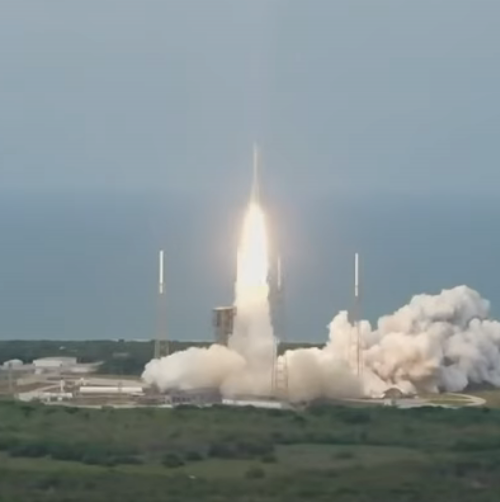Starliner successfully docks with ISS

Screen capture just after soft docking.
Boeing and NASA today successfully docked an unmanned Starliner capsule to ISS for the first time, completing the up-from-Earth portion of this demo mission to prove out this Boeing spacecraft as a future ferry to bring astronauts to and from the station.
The screen capture to the right, taken from the live feed, shows Starliner just after a successful soft capture docking. This was shortly followed by a hard dock.
They will open the hatch tomorrow after checking out the capsule’s linkage with ISS.
The docking itself was delayed by about 78 minutes, partly to time the docking during a period of good orbital communications and partly because of an issue with NASA’s own docking ring on the station that required engineers to reset it.

Screen capture just after soft docking.
Boeing and NASA today successfully docked an unmanned Starliner capsule to ISS for the first time, completing the up-from-Earth portion of this demo mission to prove out this Boeing spacecraft as a future ferry to bring astronauts to and from the station.
The screen capture to the right, taken from the live feed, shows Starliner just after a successful soft capture docking. This was shortly followed by a hard dock.
They will open the hatch tomorrow after checking out the capsule’s linkage with ISS.
The docking itself was delayed by about 78 minutes, partly to time the docking during a period of good orbital communications and partly because of an issue with NASA’s own docking ring on the station that required engineers to reset it.
On Christmas Eve 1968 three Americans became the first humans to visit another world. What they did to celebrate was unexpected and profound, and will be remembered throughout all human history. Genesis: the Story of Apollo 8, Robert Zimmerman's classic history of humanity's first journey to another world, tells that story, and it is now available as both an ebook and an audiobook, both with a foreword by Valerie Anders and a new introduction by Robert Zimmerman.
The print edition can be purchased at Amazon or any other book seller. If you want an autographed copy the price is $60 for the hardback and $45 for the paperback, plus $8 shipping for each. Go here for purchasing details. The ebook is available everywhere for $5.99 (before discount) at amazon, or direct from my ebook publisher, ebookit you don't support the big tech companies and the author gets a bigger cut much sooner.
The audiobook is also available at all these vendors, and is also free with a 30-day trial membership to Audible.
"Not simply about one mission, [Genesis] is also the history of America's quest for the moon... Zimmerman has done a masterful job of tying disparate events together into a solid account of one of America's greatest human triumphs."--San Antonio Express-News
A pair of spiral galaxies
Another cool image to herald in the weekend! The photo to the right, cropped and reduced to post here, was taken by the Hubble Space Telescope and shows a pair of spiral galaxies about 800 million light years away.
The smaller galaxy is superimposed on the larger one, which is a type of active galaxy called a Seyfert galaxy.
Seyfert galaxies are named for astronomer Carl K. Seyfert who, in 1943, published a paper about spiral galaxies with very bright emission lines. Today we know that about 10% of all galaxies may be Seyfert galaxies. They belong to the class of “active galaxies” – galaxies that have supermassive black holes at their centers accreting material, which releases vast amounts of radiation. The active cores of Seyfert galaxies are at their brightest when observed in light outside the visible spectrum. The larger galaxy in this pair is a Type II Seyfert galaxy, which means it is a very bright source of infrared and visible light.
In other words, both of these galaxies emit a lot of radiation in the infrared, radio, and X-rays due to activity taking place at the supermassive black holes believed to be at their cores.
Another cool image to herald in the weekend! The photo to the right, cropped and reduced to post here, was taken by the Hubble Space Telescope and shows a pair of spiral galaxies about 800 million light years away.
The smaller galaxy is superimposed on the larger one, which is a type of active galaxy called a Seyfert galaxy.
Seyfert galaxies are named for astronomer Carl K. Seyfert who, in 1943, published a paper about spiral galaxies with very bright emission lines. Today we know that about 10% of all galaxies may be Seyfert galaxies. They belong to the class of “active galaxies” – galaxies that have supermassive black holes at their centers accreting material, which releases vast amounts of radiation. The active cores of Seyfert galaxies are at their brightest when observed in light outside the visible spectrum. The larger galaxy in this pair is a Type II Seyfert galaxy, which means it is a very bright source of infrared and visible light.
In other words, both of these galaxies emit a lot of radiation in the infrared, radio, and X-rays due to activity taking place at the supermassive black holes believed to be at their cores.
Dry flows on Mars?
Cool image time! The picture to the right, rotated, cropped, reduced, and annotated to post here, was taken on September 21, 2021 by the high resolution camera on Mars Reconnaissance Orbiter (MRO) and shows what appear to be a variety of flows, from alluvial fill to slope streaks to dust coming down the southeastern interior rim of 77-mile-wide Orson Welles Crater on Mars.
The location is almost right on the equator, so none of these flows are ice- or water-related. Nor are such flows unusual in the meandering 800-mile-long canyon that cuts through Orson Wells crater, dubbed Shalbatana Vallis. I featured similar flows at a spot to the north and downstream from this one in May 2021, also on the canyon’s eastern rim.
The overview map below provides some context.
» Read more
Cool image time! The picture to the right, rotated, cropped, reduced, and annotated to post here, was taken on September 21, 2021 by the high resolution camera on Mars Reconnaissance Orbiter (MRO) and shows what appear to be a variety of flows, from alluvial fill to slope streaks to dust coming down the southeastern interior rim of 77-mile-wide Orson Welles Crater on Mars.
The location is almost right on the equator, so none of these flows are ice- or water-related. Nor are such flows unusual in the meandering 800-mile-long canyon that cuts through Orson Wells crater, dubbed Shalbatana Vallis. I featured similar flows at a spot to the north and downstream from this one in May 2021, also on the canyon’s eastern rim.
The overview map below provides some context.
» Read more
Now available in hardback and paperback as well as ebook!
From the press release: In this ground-breaking new history of early America, historian Robert Zimmerman not only exposes the lie behind The New York Times 1619 Project that falsely claims slavery is central to the history of the United States, he also provides profound lessons about the nature of human societies, lessons important for Americans today as well as for all future settlers on Mars and elsewhere in space.
Conscious Choice: The origins of slavery in America and why it matters today and for our future in outer space, is a riveting page-turning story that documents how slavery slowly became pervasive in the southern British colonies of North America, colonies founded by a people and culture that not only did not allow slavery but in every way were hostile to the practice.
Conscious Choice does more however. In telling the tragic history of the Virginia colony and the rise of slavery there, Zimmerman lays out the proper path for creating healthy societies in places like the Moon and Mars.
“Zimmerman’s ground-breaking history provides every future generation the basic framework for establishing new societies on other worlds. We would be wise to heed what he says.” —Robert Zubrin, founder of the Mars Society.
All editions are available at Amazon, Barnes & Noble, and all book vendors, with the ebook priced at $5.99 before discount. All editions can also be purchased direct from the ebook publisher, ebookit, in which case you don't support the big tech companies and the author gets a bigger cut much sooner.
Autographed printed copies are also available at discount directly from the author (hardback $29.95; paperback $14.95; Shipping cost for either: $6.00). Just send an email to zimmerman @ nasw dot org.
Pushback: Five bowling alleys sue Democrat Governor Gretchen Whitmer

Michigan Governor Gretchen Whitmer, Democrat and would-be dictator
Bring a gun to a knife fight: A coalition of five Michigan bowling alleys has sued Democratic Party Governor Gretchen Whitmer as well as the state’s Department of Health and Human Services Director Robert Gordon for shutting down their businesses for more than a year during the Wuhan panic without providing them any just compensation.
You can read the complaint here [pdf].
Plaintiff’s chief counsel David Kallman told The Epoch Times after the appeals court hearing…
“Michigan is the only state in the nation where a governor’s public health emergency powers were overturned as unconstitutional. If we lose in the court of appeals, we will take this case to the U.S. Supreme Court.”
Scott Bennett, executive director of the Independent Bowling and Entertainment Centers Association, told The Epoch Times: “The governor’s actions were devastating to our industry. Things went from ‘two weeks to slow the spread’ to indefinite shutdowns.”
» Read more

Michigan Governor Gretchen Whitmer, Democrat and would-be dictator
Bring a gun to a knife fight: A coalition of five Michigan bowling alleys has sued Democratic Party Governor Gretchen Whitmer as well as the state’s Department of Health and Human Services Director Robert Gordon for shutting down their businesses for more than a year during the Wuhan panic without providing them any just compensation.
You can read the complaint here [pdf].
Plaintiff’s chief counsel David Kallman told The Epoch Times after the appeals court hearing…
“Michigan is the only state in the nation where a governor’s public health emergency powers were overturned as unconstitutional. If we lose in the court of appeals, we will take this case to the U.S. Supreme Court.”Scott Bennett, executive director of the Independent Bowling and Entertainment Centers Association, told The Epoch Times: “The governor’s actions were devastating to our industry. Things went from ‘two weeks to slow the spread’ to indefinite shutdowns.”
» Read more
Perseverance’s upcoming travel plans
Today’s update from the Perseverance’s science team provided a rough outline of their travel and drill-sampling plans for the Mars rover in Jezero Crater as it begins its climb up onto the delta that once poured into the crater. The route they plan to travel initially is dubbed Hawksbill Gap.
At Hawksbill Gap, however, we may instead carry out the first portion of the sampling sol path (which includes abrasion and collecting observations using our proximity science instruments) at up to 5 locations along our ascent. After that, we’ll turn around and begin a descent back down Hawksbill Gap and collect rock core samples at 3 of our abrasion locations.
This modified sampling strategy is intended to provide the team with valuable contextual information as we climb Hawksbill Gap and interpret the delta stratigraphy around us. With proximity science data in-hand, we can down-select our sampling sites to ensure we’ll be collecting the most scientifically valuable cores along our descent. Of course, we still maintain the option of collecting sample cores at any point during our ascent, if the team decides a particular abrasion site warrants immediate sampling.
The map above shows my guess (the red dotted lines) as to their potential routes uphill. As the science team has so far not published a map indicating exactly where Hawksbill Gap is, I can only guess at this point. The blue dot indicates Perseverance’s present position, the green dot Ingenuity.
As for the helicopter, there is no word yet whether the engineers have successfully gotten its batteries back to full charge. Until then, it cannot fly, and is also at risk of freezing up in the cold Martian winter.
Today’s update from the Perseverance’s science team provided a rough outline of their travel and drill-sampling plans for the Mars rover in Jezero Crater as it begins its climb up onto the delta that once poured into the crater. The route they plan to travel initially is dubbed Hawksbill Gap.
At Hawksbill Gap, however, we may instead carry out the first portion of the sampling sol path (which includes abrasion and collecting observations using our proximity science instruments) at up to 5 locations along our ascent. After that, we’ll turn around and begin a descent back down Hawksbill Gap and collect rock core samples at 3 of our abrasion locations.
This modified sampling strategy is intended to provide the team with valuable contextual information as we climb Hawksbill Gap and interpret the delta stratigraphy around us. With proximity science data in-hand, we can down-select our sampling sites to ensure we’ll be collecting the most scientifically valuable cores along our descent. Of course, we still maintain the option of collecting sample cores at any point during our ascent, if the team decides a particular abrasion site warrants immediate sampling.
The map above shows my guess (the red dotted lines) as to their potential routes uphill. As the science team has so far not published a map indicating exactly where Hawksbill Gap is, I can only guess at this point. The blue dot indicates Perseverance’s present position, the green dot Ingenuity.
As for the helicopter, there is no word yet whether the engineers have successfully gotten its batteries back to full charge. Until then, it cannot fly, and is also at risk of freezing up in the cold Martian winter.
Leaving Earth: Space Stations, Rival Superpowers, and the Quest for Interplanetary Travel, can be purchased as an ebook everywhere for only $3.99 (before discount) at amazon, Barnes & Noble, all ebook vendors, or direct from my ebook publisher, ebookit.
If you buy it from ebookit you don't support the big oppressive tech companies and I get a bigger cut much sooner.
Winner of the 2003 Eugene M. Emme Award of the American Astronautical Society.
"Leaving Earth is one of the best and certainly the most comprehensive summary of our drive into space that I have ever read. It will be invaluable to future scholars because it will tell them how the next chapter of human history opened." -- Arthur C. Clarke
India delays launch of manned mission to do two abort tests first
The new colonial movement: India’s space agency ISRO has decided to delay the launch of its Gaganyaan manned orbital mission at least one more year (until ’24) in order to do two abort tests of the capsule.
“The first Test Vehicle for this purpose is ready and we will launch it in September this year. The human capsule will be sent up 15 kilometres, we will simulate an abort and then the capsule will be safely brought down by parachutes into the sea,’’ Somanath, who is also Secretary, Department of Space, said.
The second Test Vehicle will be launched in December this year, sent to a greater height and then brought back after a similar simulation is carried out.
The mission had originally been scheduled to launch in ’22, but was delayed significantly by India’s panic over Wuhan.
The new colonial movement: India’s space agency ISRO has decided to delay the launch of its Gaganyaan manned orbital mission at least one more year (until ’24) in order to do two abort tests of the capsule.
“The first Test Vehicle for this purpose is ready and we will launch it in September this year. The human capsule will be sent up 15 kilometres, we will simulate an abort and then the capsule will be safely brought down by parachutes into the sea,’’ Somanath, who is also Secretary, Department of Space, said.
The second Test Vehicle will be launched in December this year, sent to a greater height and then brought back after a similar simulation is carried out.
The mission had originally been scheduled to launch in ’22, but was delayed significantly by India’s panic over Wuhan.
Zhurong goes into hibernation

According to a report today in China’s state-run press, the team running its Zhurong Mars rover have placed it into a hibernation mode in order to sit out the Martian winter.
To tackle the dust storms and low-temperature challenges, the Chinese rover went into dormancy on Wednesday. It is expected to wake up and resume work in December when the dust clears and Mars enters its spring season, the administration said in a statement.
The rover sits somewhere in the blue circle in the map to the right, created using elevation data and images from Mars Reconnaissance Orbiter (MRO). This region is about 25 degrees north latitude, so though it is in the dry equatorial regions of Mars, it still gets very cold in winter, down to -180 degrees Fahrenheit at night. Furthermore, the increased winter dust storms block the light from the Sun, which reduces the available power the rover’s solar panels can produce.
Chinese engineers have apparently adapted the hibernation techniques they use on the Moon with their Yutu-2 rover to place Zhurong in hibernation.

According to a report today in China’s state-run press, the team running its Zhurong Mars rover have placed it into a hibernation mode in order to sit out the Martian winter.
To tackle the dust storms and low-temperature challenges, the Chinese rover went into dormancy on Wednesday. It is expected to wake up and resume work in December when the dust clears and Mars enters its spring season, the administration said in a statement.
The rover sits somewhere in the blue circle in the map to the right, created using elevation data and images from Mars Reconnaissance Orbiter (MRO). This region is about 25 degrees north latitude, so though it is in the dry equatorial regions of Mars, it still gets very cold in winter, down to -180 degrees Fahrenheit at night. Furthermore, the increased winter dust storms block the light from the Sun, which reduces the available power the rover’s solar panels can produce.
Chinese engineers have apparently adapted the hibernation techniques they use on the Moon with their Yutu-2 rover to place Zhurong in hibernation.
Starliner reaches proper orbit despite thruster problems
Unbelievable: During the post-launch press conference last night Boeing officials revealed that, though the final burn to get Boeing’s Starliner capsule into orbit using its own thrusters succeeded, the thrusters did not function as planned.
Boeing Vice President Mark Nappi said a Starliner thruster failed after firing for one second as the spacecraft made a burn to enter orbit after separating from its Atlas V launch vehicle. The flight software switched to a second thruster, which fired for 25 seconds before shutting down prematurely. A third thruster took over and completed the firing, Nappi said.
The thrusters were made by Aerojet Rocketdyne, which also made the valves that did not work in the previous launch attempt in the summer of 2021. Whether the two problems are related is not known at this time.
A NASA official also noted that a cooling unit on the spacecraft operated “sluggishly during ascent,” but began working correctly once in orbit.
Right now NASA and Boeing are planning to proceed with the docking on ISS tonight at 7:10 pm (Eastern). It appears that though two thrusters have failed, they have ten more thrusters that can be used for further maneuvers throughout the mission. Furthermore, these thrusters are not used during the actual rendezvous and docking.
The live stream of the docking goes live at 3:30 pm (Eastern), and is embedded below. Until then enjoy NASA propaganda, some of it might be of interest.
Update: NASA has cut off coverage of the docking on the channel I had embedded previously. I have now embedded an active live feed.
Unbelievable: During the post-launch press conference last night Boeing officials revealed that, though the final burn to get Boeing’s Starliner capsule into orbit using its own thrusters succeeded, the thrusters did not function as planned.
Boeing Vice President Mark Nappi said a Starliner thruster failed after firing for one second as the spacecraft made a burn to enter orbit after separating from its Atlas V launch vehicle. The flight software switched to a second thruster, which fired for 25 seconds before shutting down prematurely. A third thruster took over and completed the firing, Nappi said.
The thrusters were made by Aerojet Rocketdyne, which also made the valves that did not work in the previous launch attempt in the summer of 2021. Whether the two problems are related is not known at this time.
A NASA official also noted that a cooling unit on the spacecraft operated “sluggishly during ascent,” but began working correctly once in orbit.
Right now NASA and Boeing are planning to proceed with the docking on ISS tonight at 7:10 pm (Eastern). It appears that though two thrusters have failed, they have ten more thrusters that can be used for further maneuvers throughout the mission. Furthermore, these thrusters are not used during the actual rendezvous and docking.
The live stream of the docking goes live at 3:30 pm (Eastern), and is embedded below. Until then enjoy NASA propaganda, some of it might be of interest.
Update: NASA has cut off coverage of the docking on the channel I had embedded previously. I have now embedded an active live feed.
Charles Ives – Symphony No. 2
An evening pause: This is long for an evening pause, but you can let it play in the background if you have other things to do. Recorded live January 2022 in Amsterdam.
Hat tip Dan Morris.
ULA’s Atlas-5 rocket successfully launches Starliner into orbit

Screen capture just after lift-off
Capitalism in space: ULA’s Atlas-5 rocket today successfully launched Boeing’s manned Starliner capsule into orbit on its second attempt to complete an unmanned demo mission to ISS.
The capsule having been deployed by the rocket then followed with a final burn using the capsule’s own engines to get into its proper orbit for rendezvous with ISS tomorrow at 7:10 pm (Eastern). It was during this rendezvous period that Starliner had its problems in the first demo mission in December 2019 that caused the mission to be aborted prior to docking. Hopefully those software issues have been solved and all will go well through tomorrow.
It is interesting to compare the operation and equipment of Boeing/ULA vs SpaceX. While SpaceX has aimed for a sleek look, Boeing/ULA both retain the industrial feel of past rocketry. Neither is wrong, but the difference highlights the consequences of having competing operations. You get variety.
The leaders in the 2022 launch race:
21 SpaceX
15 China
7 Russia
3 Rocket Lab
3 ULA
American private enterprise now leads China 30 to 15 in the national rankings, and the entire world combined 30 to 25.

Screen capture just after lift-off
Capitalism in space: ULA’s Atlas-5 rocket today successfully launched Boeing’s manned Starliner capsule into orbit on its second attempt to complete an unmanned demo mission to ISS.
The capsule having been deployed by the rocket then followed with a final burn using the capsule’s own engines to get into its proper orbit for rendezvous with ISS tomorrow at 7:10 pm (Eastern). It was during this rendezvous period that Starliner had its problems in the first demo mission in December 2019 that caused the mission to be aborted prior to docking. Hopefully those software issues have been solved and all will go well through tomorrow.
It is interesting to compare the operation and equipment of Boeing/ULA vs SpaceX. While SpaceX has aimed for a sleek look, Boeing/ULA both retain the industrial feel of past rocketry. Neither is wrong, but the difference highlights the consequences of having competing operations. You get variety.
The leaders in the 2022 launch race:
21 SpaceX
15 China
7 Russia
3 Rocket Lab
3 ULA
American private enterprise now leads China 30 to 15 in the national rankings, and the entire world combined 30 to 25.
Pushback: Two Alaska Airlines flight attendants fired for asking questions file lawsuit

Alaska Airlines: Opposed to free speech and religious freedom
Picture credit: Quintin Soloviev
Bring a gun to a knife fight: Today’s blacklist story is a follow-up on a September 2021 story about two flight attendants — Marli Brown and Lacey Smith — who were fired by Alaska Airlines because they had the nerve to question the airline’s public support of a gay rights bill, and asked those questions on a forum the airline had itself arranged for employees to comment.
At the time the attendants, represented by the First Liberty Institute, had filed a complaint with the Equal Employment Opportunity Commission (EEOC), which recently issued “right-to-sue” letters to both attendants.
First Liberty has now filed its lawsuit, which you can read here [pdf]. The suit is against both Alaska Airlines and the Association of Flight Attendants Association of the AFL-CIO that failed to defend both Brown and Smith. From the complaint:
On February 25, 2021, Alaska Airlines posted an article about its support for the Equality Act to an internal employee message board and solicited employee comments. The Equality Act is proposed legislation that would add “sexual orientation and gender identity” as protected classes to a variety of federal statutes and would curtail the applicability of the Religious Freedom Restoration Act.
In response, Marli and Lacey felt compelled by their Christian faith to post one comment each, asking about the impact of the Equality Act on civil rights for religion and women in the workplace.
Alaska Airlines responded to Marli and Lacey’s posts by immediately removing Marli and Lacey from their flight schedules, terminating their employment, and disparaging their religious expression and beliefs as “discriminatory,” “hateful,” and “offensive.”
» Read more

Alaska Airlines: Opposed to free speech and religious freedom
Picture credit: Quintin Soloviev
Bring a gun to a knife fight: Today’s blacklist story is a follow-up on a September 2021 story about two flight attendants — Marli Brown and Lacey Smith — who were fired by Alaska Airlines because they had the nerve to question the airline’s public support of a gay rights bill, and asked those questions on a forum the airline had itself arranged for employees to comment.
At the time the attendants, represented by the First Liberty Institute, had filed a complaint with the Equal Employment Opportunity Commission (EEOC), which recently issued “right-to-sue” letters to both attendants.
First Liberty has now filed its lawsuit, which you can read here [pdf]. The suit is against both Alaska Airlines and the Association of Flight Attendants Association of the AFL-CIO that failed to defend both Brown and Smith. From the complaint:
On February 25, 2021, Alaska Airlines posted an article about its support for the Equality Act to an internal employee message board and solicited employee comments. The Equality Act is proposed legislation that would add “sexual orientation and gender identity” as protected classes to a variety of federal statutes and would curtail the applicability of the Religious Freedom Restoration Act.
In response, Marli and Lacey felt compelled by their Christian faith to post one comment each, asking about the impact of the Equality Act on civil rights for religion and women in the workplace.
Alaska Airlines responded to Marli and Lacey’s posts by immediately removing Marli and Lacey from their flight schedules, terminating their employment, and disparaging their religious expression and beliefs as “discriminatory,” “hateful,” and “offensive.”
» Read more
ESA releases new images from Solar Orbiter

The Sun’s south pole, as seen by Solar Orbiter at perihelion. Click for full movie.
The European Space Agency (ESA) yesterday released a few of the images taken by its Solar Orbiter spacecraft before and during its first perihelion (closest point in its orbit) on March 26, 2022.
The spacecraft was inside the orbit of Mercury, at about one-third the distance from the Sun to the Earth, and its heatshield was reaching around 500°C. But it dissipated that heat with its innovative technology to keep the spacecraft safe and functioning.
Solar Orbiter carries ten science instruments – nine are led by ESA Member States and one by NASA – all working together in close collaboration to provide unprecedented insight into how our local star ‘works’. Some are remote-sensing instruments that look at the Sun, while others are in-situ instruments that monitor the conditions around the spacecraft, enabling scientists to ‘join the dots’ from what they see happening at the Sun, to what Solar Orbiter ‘feels’ at its location in the solar wind millions of kilometres away.
The photo above, cropped, reduced, and revised slightly to post here, looks at the Sun’s south pole, from the side. The surface of the Sun (the top two thirds) almost looks like thunderheads on Earth, except the rain coming from them are high energy heat and radiation.
The data produced a lot of fascinating short movies, all available at the link, including a phenomenon the scientists have nicknamed a “space hedgehog” because of its look. About 15,000 miles across, “At present no one knows exactly what it is or how it formed in the Sun’s atmosphere.”

The Sun’s south pole, as seen by Solar Orbiter at perihelion. Click for full movie.
The European Space Agency (ESA) yesterday released a few of the images taken by its Solar Orbiter spacecraft before and during its first perihelion (closest point in its orbit) on March 26, 2022.
The spacecraft was inside the orbit of Mercury, at about one-third the distance from the Sun to the Earth, and its heatshield was reaching around 500°C. But it dissipated that heat with its innovative technology to keep the spacecraft safe and functioning.
Solar Orbiter carries ten science instruments – nine are led by ESA Member States and one by NASA – all working together in close collaboration to provide unprecedented insight into how our local star ‘works’. Some are remote-sensing instruments that look at the Sun, while others are in-situ instruments that monitor the conditions around the spacecraft, enabling scientists to ‘join the dots’ from what they see happening at the Sun, to what Solar Orbiter ‘feels’ at its location in the solar wind millions of kilometres away.
The photo above, cropped, reduced, and revised slightly to post here, looks at the Sun’s south pole, from the side. The surface of the Sun (the top two thirds) almost looks like thunderheads on Earth, except the rain coming from them are high energy heat and radiation.
The data produced a lot of fascinating short movies, all available at the link, including a phenomenon the scientists have nicknamed a “space hedgehog” because of its look. About 15,000 miles across, “At present no one knows exactly what it is or how it formed in the Sun’s atmosphere.”
Watching Boeing’s Starliner launch tonight
At 6:54 pm (Eastern) tonight a ULA Atlas-5 rocket will launch Boeing’s manned Starliner capsule on its second attempt to complete an unmanned demo mission to ISS.
NASA’s live coverage will begin at 6 pm on NASA-TV. I have embedded the youtube channel of this live stream below the fold. At the moment the station is broadcasting its regular NASA propaganda (some of which is actually informative). The launch’s actual coverage will begin at 6 pm (Eastern), and continue until the spacecraft is successfully inserted into orbit. Further coverage of the flight, including docking with ISS, will be as follows:
9 pm (Eastern) – Post launch press conference (time subject to change).
May 20
3:30 pm (Eastern) – Coverage begins of the rendezvous and docking to ISS, with the actual docking scheduled for 7:10 pm (Eastern).
May 21
11:30 am (Eastern) – Coverage of the opening of Starliner’s hatch, scheduled for 11:45 am (Eastern).
Boeing’s first attempt to complete this mission in December 2019 was forced to return to Earth before docking with ISS because of numerous software issues. Then, an attempt to launch again in August 2021 was scrubbed because numerous valves in the capsule’s service module failed to operate properly during the countdown. The company had to return the capsule to the factory to replace that service module as well as make some changes to the valves to make today’s launch possible.
For Boeing, these delays and fixes have cost the company a lot of money, since its contract with NASA is fixed price. This second demo mission will cost Boeing about $400 million, but even worse, the delays meant that SpaceX got some of the business with NASA and other private customers that it might have gotten had Starliner been operational.
Update: NASA has cut off coverage of the docking on the channel I had embedded previously. I have now embedded an active live feed.
At 6:54 pm (Eastern) tonight a ULA Atlas-5 rocket will launch Boeing’s manned Starliner capsule on its second attempt to complete an unmanned demo mission to ISS.
NASA’s live coverage will begin at 6 pm on NASA-TV. I have embedded the youtube channel of this live stream below the fold. At the moment the station is broadcasting its regular NASA propaganda (some of which is actually informative). The launch’s actual coverage will begin at 6 pm (Eastern), and continue until the spacecraft is successfully inserted into orbit. Further coverage of the flight, including docking with ISS, will be as follows:
9 pm (Eastern) – Post launch press conference (time subject to change).
May 20
3:30 pm (Eastern) – Coverage begins of the rendezvous and docking to ISS, with the actual docking scheduled for 7:10 pm (Eastern).
May 21
11:30 am (Eastern) – Coverage of the opening of Starliner’s hatch, scheduled for 11:45 am (Eastern).
Boeing’s first attempt to complete this mission in December 2019 was forced to return to Earth before docking with ISS because of numerous software issues. Then, an attempt to launch again in August 2021 was scrubbed because numerous valves in the capsule’s service module failed to operate properly during the countdown. The company had to return the capsule to the factory to replace that service module as well as make some changes to the valves to make today’s launch possible.
For Boeing, these delays and fixes have cost the company a lot of money, since its contract with NASA is fixed price. This second demo mission will cost Boeing about $400 million, but even worse, the delays meant that SpaceX got some of the business with NASA and other private customers that it might have gotten had Starliner been operational.
Update: NASA has cut off coverage of the docking on the channel I had embedded previously. I have now embedded an active live feed.
Technical issue on New Shepard delays fifth passenger flight
Capitalism in space: Because of an as yet unexplained technical issue discovered on its New Shepard suborbital spacecraft, Blue Origin has scrubbed tomorrow’s planned fifth passenger flight.
The only information the company released was in a tweet yesterday:
During our final vehicle check-outs, we observed one of New Shepard’s back-up systems was not meeting our expectations for performance.
No other information has so far been released, nor has the company indicated when the flight might be rescheduled. It is intended to carry six passengers on a short suborbital flight, including one making his second flight on New Shepard.
Capitalism in space: Because of an as yet unexplained technical issue discovered on its New Shepard suborbital spacecraft, Blue Origin has scrubbed tomorrow’s planned fifth passenger flight.
The only information the company released was in a tweet yesterday:
During our final vehicle check-outs, we observed one of New Shepard’s back-up systems was not meeting our expectations for performance.
No other information has so far been released, nor has the company indicated when the flight might be rescheduled. It is intended to carry six passengers on a short suborbital flight, including one making his second flight on New Shepard.
Puzzling telemetry from Voyager-1 suggests problem
Engineers are puzzling over strange operational data coming from Voyager-1, launched in 1977 and now in interstellar space more than 14 billion miles away, that suggests a technical problem but also makes no sense.
The engineering team with NASA’s Voyager 1 spacecraft is trying to solve a mystery: The interstellar explorer is operating normally, receiving and executing commands from Earth, along with gathering and returning science data. But readouts from the probe’s attitude articulation and control system (AACS) don’t reflect what’s actually happening onboard.
The AACS controls the 45-year-old spacecraft’s orientation. Among other tasks, it keeps Voyager 1’s high-gain antenna pointed precisely at Earth, enabling it to send data home. All signs suggest the AACS is still working, but the telemetry data it’s returning is invalid. For instance, the data may appear to be randomly generated, or does not reflect any possible state the AACS could be in.
The issue hasn’t triggered any onboard fault protection systems, which are designed to put the spacecraft into “safe mode” – a state where only essential operations are carried out, giving engineers time to diagnose an issue. Voyager 1’s signal hasn’t weakened, either, which suggests the high-gain antenna remains in its prescribed orientation with Earth.
Figuring out what has happened is made more difficult by distance. It takes about 20 hours for signals to get from Voyager-1 to Earth, even at the speed of light. Thus, any attempted fix will arrive almost two days after it first occurred, at the soonest.
Both Voyager-1 and Voyager-2 are still operating, though at significantly reduced power. It is expected that sometime in the next few years their nuclear power sources will finally be unable to produce enough power to keep them functioning. If so, both spacecraft will have survived the maximum time predicted when launched.
Engineers are puzzling over strange operational data coming from Voyager-1, launched in 1977 and now in interstellar space more than 14 billion miles away, that suggests a technical problem but also makes no sense.
The engineering team with NASA’s Voyager 1 spacecraft is trying to solve a mystery: The interstellar explorer is operating normally, receiving and executing commands from Earth, along with gathering and returning science data. But readouts from the probe’s attitude articulation and control system (AACS) don’t reflect what’s actually happening onboard.
The AACS controls the 45-year-old spacecraft’s orientation. Among other tasks, it keeps Voyager 1’s high-gain antenna pointed precisely at Earth, enabling it to send data home. All signs suggest the AACS is still working, but the telemetry data it’s returning is invalid. For instance, the data may appear to be randomly generated, or does not reflect any possible state the AACS could be in.
The issue hasn’t triggered any onboard fault protection systems, which are designed to put the spacecraft into “safe mode” – a state where only essential operations are carried out, giving engineers time to diagnose an issue. Voyager 1’s signal hasn’t weakened, either, which suggests the high-gain antenna remains in its prescribed orientation with Earth.
Figuring out what has happened is made more difficult by distance. It takes about 20 hours for signals to get from Voyager-1 to Earth, even at the speed of light. Thus, any attempted fix will arrive almost two days after it first occurred, at the soonest.
Both Voyager-1 and Voyager-2 are still operating, though at significantly reduced power. It is expected that sometime in the next few years their nuclear power sources will finally be unable to produce enough power to keep them functioning. If so, both spacecraft will have survived the maximum time predicted when launched.
Russia launches military satellite with Soyuz-2 rocket
Russia’s military today successfully used a Soyuz-2 rocket to launch a satellite believed designed to map precisely the Earth’s topography.
The leaders in the 2022 launch race:
21 SpaceX
15 China
7 Russia
3 Rocket Lab
2 ULA
The U.S. still leads China 29 to 15 in the national rankings, and entire world combined 29 to 25.
Russia’s military today successfully used a Soyuz-2 rocket to launch a satellite believed designed to map precisely the Earth’s topography.
The leaders in the 2022 launch race:
21 SpaceX
15 China
7 Russia
3 Rocket Lab
2 ULA
The U.S. still leads China 29 to 15 in the national rankings, and entire world combined 29 to 25.
May 18, 2022 Zimmerman/Batchelor podcast
Embedded below the fold in two parts.
To listen to all of John Batchelor’s podcasts, well worth your time, go here.
» Read more
Embedded below the fold in two parts.
To listen to all of John Batchelor’s podcasts, well worth your time, go here.
» Read more
Tedeschi Trucks Band – Midnight in Harlem
An evening pause: We’ve seen them before. This is just another grand live performance from Derek Trucks, Susan Tedeschi, and their band.
Hat tip from Rex Ridenoure.
A giant elliptical galaxy
Cool image time! The image to the right, reduced to post here, was taken by the Hubble Space Telescope of the giant elliptical galaxy NGC 474.
Located some 100 million light-years from Earth, NGC 474 spans about 250,000 light-years across – that’s 2.5 times larger than our own Milky Way galaxy! Along with its enormous size, NGC 474 has a series of complex layered shells that surround its spherical-shaped core. The cause of these shells is unknown, but astronomers theorize that they may be the aftereffects of the giant galaxy absorbing one or more smaller galaxies. In the same way a pebble creates ripples on a pond when dropped into the water, the absorbed galaxy creates waves that form the shells.
About 10% of elliptical galaxies have shell structures, but unlike the majority of elliptical galaxies, which are associated with galaxy clusters, shelled ellipticals usually lie in relatively empty space. It may be that they’ve cannibalized their neighbors.
NGC 474 is no exception, also located in a relatively empty region of space.
Cool image time! The image to the right, reduced to post here, was taken by the Hubble Space Telescope of the giant elliptical galaxy NGC 474.
Located some 100 million light-years from Earth, NGC 474 spans about 250,000 light-years across – that’s 2.5 times larger than our own Milky Way galaxy! Along with its enormous size, NGC 474 has a series of complex layered shells that surround its spherical-shaped core. The cause of these shells is unknown, but astronomers theorize that they may be the aftereffects of the giant galaxy absorbing one or more smaller galaxies. In the same way a pebble creates ripples on a pond when dropped into the water, the absorbed galaxy creates waves that form the shells.
About 10% of elliptical galaxies have shell structures, but unlike the majority of elliptical galaxies, which are associated with galaxy clusters, shelled ellipticals usually lie in relatively empty space. It may be that they’ve cannibalized their neighbors.
NGC 474 is no exception, also located in a relatively empty region of space.
Today’s blacklisted American: Student expelled for not getting COVID booster, despite proof the booster for her was medically risky

Diamond “Ellie” Puentes, blacklisted because she believes
in “her body, her choice!”
They’re coming for you next: A student at Union College in New York, Diamond “Ellie” Puentes, was expelled from school because she refused to get a COVID booster because of the serious adverse effects she experienced after getting her second COVID shot.
More information here.
Worse, the school refused to accept her doctor’s note requesting she be exempt, or her hospital records describing the health issues she had experienced. From the first link above:
Union College’s Director of Health Services Angela Stefanatos asked her, “Are you here because you don’t want to get the booster or because you’re truly sick?”
Dr. Thomas Nelson, Puentes’ primary care physician, wrote a letter addressed to the college on April 11 regarding his patient’s concerns with the booster shot. He stated that Puentes was “in an unfavorable state of health, presumably caused by the vaccine itself.”
» Read more

Diamond “Ellie” Puentes, blacklisted because she believes
in “her body, her choice!”
They’re coming for you next: A student at Union College in New York, Diamond “Ellie” Puentes, was expelled from school because she refused to get a COVID booster because of the serious adverse effects she experienced after getting her second COVID shot.
More information here.
Worse, the school refused to accept her doctor’s note requesting she be exempt, or her hospital records describing the health issues she had experienced. From the first link above:
Union College’s Director of Health Services Angela Stefanatos asked her, “Are you here because you don’t want to get the booster or because you’re truly sick?”
Dr. Thomas Nelson, Puentes’ primary care physician, wrote a letter addressed to the college on April 11 regarding his patient’s concerns with the booster shot. He stated that Puentes was “in an unfavorable state of health, presumably caused by the vaccine itself.”
» Read more
Pro-abortion advocates threaten to storm the Supreme Court, burn it down, and murder justices
Real insurrection: According to a Homeland Security memo, pro-abortion protesters have been organizing to storm the Supreme Court, burn it down, and murder justices in protest should the court decide to overturn Roe v. Wade.
The threats also included attacking places of worship as well as anti-abortion clinics.
As is typical nowadays, Homeland Security tried to de-emphasize the seriousness of these threats of violence from the left by first hinting it was really a response to white supremacy and thus possibly justified, and then claiming such violence is really nothing more than constitutional protected speech. These two quotes from the memo from this Axios story illustrate this:
“Some racially or ethnically motivated violent extremists’ embrace of pro-life narratives may be linked to the perception of wanting to ‘save white children’ and ‘fight white genocide,'” the memo … says.
But the memo warns that this time, extremist acts could come from abortion-rights proponents as well. [However] “The mere advocacy of political or social positions, political activism, use of strong rhetoric, or generalized philosophic embrace of violent tactics does not constitute domestic violent extremism or illegal activity and is constitutionally protected.”
As always, our leftist government uses the premises of the left to excuse leftist violence. To them, the violence of the left is merely speech, while the speech of the right is violence, and must be silenced.
Should the Supreme Court overturn Roe v. Wade, we should all be prepared for riots as bad or worse as those that occurred after George Floyd’s death. This memo is merely stating the obvious. Since the election of Donald Trump in 2016 the left has decided that the only democracy and law it accepts is one in which it gets its way, every single time.
We should also be prepared for our government to do nothing to stop it, and if any rioters are captured to arrange their release as quickly as possible. These protests are certainly intended as a weapon to warp the results of November’s election, in favor of Democrats. Remember, the violent leftist protesters are merely the storm-troopers of the Democratic Party, used to promote violence in order to make possible the reelection of its politicians, by hook or by crook.
Real insurrection: According to a Homeland Security memo, pro-abortion protesters have been organizing to storm the Supreme Court, burn it down, and murder justices in protest should the court decide to overturn Roe v. Wade.
The threats also included attacking places of worship as well as anti-abortion clinics.
As is typical nowadays, Homeland Security tried to de-emphasize the seriousness of these threats of violence from the left by first hinting it was really a response to white supremacy and thus possibly justified, and then claiming such violence is really nothing more than constitutional protected speech. These two quotes from the memo from this Axios story illustrate this:
“Some racially or ethnically motivated violent extremists’ embrace of pro-life narratives may be linked to the perception of wanting to ‘save white children’ and ‘fight white genocide,'” the memo … says.
But the memo warns that this time, extremist acts could come from abortion-rights proponents as well. [However] “The mere advocacy of political or social positions, political activism, use of strong rhetoric, or generalized philosophic embrace of violent tactics does not constitute domestic violent extremism or illegal activity and is constitutionally protected.”
As always, our leftist government uses the premises of the left to excuse leftist violence. To them, the violence of the left is merely speech, while the speech of the right is violence, and must be silenced.
Should the Supreme Court overturn Roe v. Wade, we should all be prepared for riots as bad or worse as those that occurred after George Floyd’s death. This memo is merely stating the obvious. Since the election of Donald Trump in 2016 the left has decided that the only democracy and law it accepts is one in which it gets its way, every single time.
We should also be prepared for our government to do nothing to stop it, and if any rioters are captured to arrange their release as quickly as possible. These protests are certainly intended as a weapon to warp the results of November’s election, in favor of Democrats. Remember, the violent leftist protesters are merely the storm-troopers of the Democratic Party, used to promote violence in order to make possible the reelection of its politicians, by hook or by crook.
The tuffy ground in the foothills of Mount Sharp
Cool image time! The photo to the right, reduced and enhanced to post here, was taken on May 13, 2022 by the high resolution camera on the rover Curiosity, looking down at some of the unusual features on the ground near the rover.
The lighter circular feature in the center is not natural, but created by Curiosity’s Dust Removal Tool (DRT). As explained on May 16th on the science team’s blog:
When that dust settles on rocks, it can partially mask the chemistry and surface texture of these rocks from APXS and MAHLI in particular [two other Curiosity instruments]. Brushing rock surfaces with the DRT is not always possible, but it does improve scientific assessments of these surfaces.
What attracted me to this photo was the tuff-like look of that uplifted flat rock. It looks just like many surfaces one sees in a cave, where the surface gets covered with calcite flowstone or popcorn, due to either water flow or condensation and then evaporation of calcite-saturated water on the surface. In this case the cave formation this flat rock most resembles visually is shelfstone, though the formation process and chemistry was certainly different. It does suggest strongly however that some form of water process occurred here.
Cool image time! The photo to the right, reduced and enhanced to post here, was taken on May 13, 2022 by the high resolution camera on the rover Curiosity, looking down at some of the unusual features on the ground near the rover.
The lighter circular feature in the center is not natural, but created by Curiosity’s Dust Removal Tool (DRT). As explained on May 16th on the science team’s blog:
When that dust settles on rocks, it can partially mask the chemistry and surface texture of these rocks from APXS and MAHLI in particular [two other Curiosity instruments]. Brushing rock surfaces with the DRT is not always possible, but it does improve scientific assessments of these surfaces.
What attracted me to this photo was the tuff-like look of that uplifted flat rock. It looks just like many surfaces one sees in a cave, where the surface gets covered with calcite flowstone or popcorn, due to either water flow or condensation and then evaporation of calcite-saturated water on the surface. In this case the cave formation this flat rock most resembles visually is shelfstone, though the formation process and chemistry was certainly different. It does suggest strongly however that some form of water process occurred here.
May 18, 2022 Zimmerman/Pratt on Texas podcast
Yesterday I recorded a long appearance discussing some recent blacklist stories with Robert Pratt for his Pratt on Texas podcast. He divided the interview into two parts, which I have embedded below. They can also be found here and here.
His full list of podcasts can be listened to here. All are well worth your time.
» Read more
Yesterday I recorded a long appearance discussing some recent blacklist stories with Robert Pratt for his Pratt on Texas podcast. He divided the interview into two parts, which I have embedded below. They can also be found here and here.
His full list of podcasts can be listened to here. All are well worth your time.
» Read more
NASA announces new possible launch dates for first SLS launch
NASA on May 16th announced the new possible launch dates for first SLS launch, outlining potential launch windows through the first half of 2023, with the first at the end of July 2022.
The calendar of launch windows through June of ’23 can be viewed here [pdf].
The July 26th to August 10th window is the one the agency is clearly targeting for that first launch, but it will not confirm this until after SLS successfully completes the next dress rehearsal countdown attempt in June. That the agency is now showing us potential launch dates in ’23 also suggests it is anticipating the possibility the launch could be delayed that much, especially if it determines it must replace the SLS’s two solid rocket boosters because they have been stacked unused for too long.
SLS was initially planned for a launch in 2015. It is now seven-plus years behind schedule, which is how long it took SpaceX to go from a blank sheet of paper to launching its Falcon Heavy for the first time.
NASA on May 16th announced the new possible launch dates for first SLS launch, outlining potential launch windows through the first half of 2023, with the first at the end of July 2022.
The calendar of launch windows through June of ’23 can be viewed here [pdf].
The July 26th to August 10th window is the one the agency is clearly targeting for that first launch, but it will not confirm this until after SLS successfully completes the next dress rehearsal countdown attempt in June. That the agency is now showing us potential launch dates in ’23 also suggests it is anticipating the possibility the launch could be delayed that much, especially if it determines it must replace the SLS’s two solid rocket boosters because they have been stacked unused for too long.
SLS was initially planned for a launch in 2015. It is now seven-plus years behind schedule, which is how long it took SpaceX to go from a blank sheet of paper to launching its Falcon Heavy for the first time.
NASA bans American spacewalks on ISS because of chronic spacesuit issues

NASA’s failed Moon spacesuits
Because of repeated water leaks in the helmets of NASA’s complex spacesuits and the agency’s inability to fix the problem, agency managers have to decided to cease all American spacewalks on ISS until engineers can definitively solve the problem.
The problem first occurred during a 2013 spacewalk, causing a major investigation. Though engineers managed to gain some control over the problem, it was never truly solved. In the most recent spacewalk on March 23rd, astronauts found water inside one helmet after the walk was over. That suit will now be returned to Earth for inspection and engineering work.
This suspension of spacewalks likely delays four spacewalks planned this year to complete the upgrade to the station’s power system.
Meanwhile, NASA’s own program to build new spacesuits for its lunar missions has been an utter failure — costing more than a billion dollars over fourteen years and producing nothing — thus forcing the agency to turn to the private sector to get new suits.

NASA’s failed Moon spacesuits
Because of repeated water leaks in the helmets of NASA’s complex spacesuits and the agency’s inability to fix the problem, agency managers have to decided to cease all American spacewalks on ISS until engineers can definitively solve the problem.
The problem first occurred during a 2013 spacewalk, causing a major investigation. Though engineers managed to gain some control over the problem, it was never truly solved. In the most recent spacewalk on March 23rd, astronauts found water inside one helmet after the walk was over. That suit will now be returned to Earth for inspection and engineering work.
This suspension of spacewalks likely delays four spacewalks planned this year to complete the upgrade to the station’s power system.
Meanwhile, NASA’s own program to build new spacesuits for its lunar missions has been an utter failure — costing more than a billion dollars over fourteen years and producing nothing — thus forcing the agency to turn to the private sector to get new suits.
ABL completes and ships new upper stage only 4 months after test explosion
Capitalism in space: The smallsat rocket startup ABL has successfully completed construction and testing of a new upper stage for the first launch of its RS1 rocket, shipping it to the launch site in Alaska only four months after an explosion during testing destroyed an earlier stage.
Before the January accident, the company had planned a first launch of the RS1 rocket, capable of placing up to 1,350 kilograms into low Earth orbit for a list price of $12 million, early in the year. Shortly after the accident, the company estimated a three-month delay in its plans. Piemont said after the recent acceptance tests that the company was now targeting “early summer” for its first launch, pending completion of acceptance tests of the first stage.
Though the company’s goal had been to lose only three months and the actual delay was four months, the overall speed in which it recovered is impressive. Right now ABL is one of four smallsat rocket companies (ABL, Firefly, Aevum, and Relativity) attempting to complete its first launch this year. This success suggests ABL has a good chance of succeeding.
Below is a video of a successful static fire test of this new stage, released by the company. It is a pleasant change from most such PR videos, in that the company simply shows us the test, with some minor editing, but includes no dramatic but fake background music. Life isn’t a movie.
» Read more
Capitalism in space: The smallsat rocket startup ABL has successfully completed construction and testing of a new upper stage for the first launch of its RS1 rocket, shipping it to the launch site in Alaska only four months after an explosion during testing destroyed an earlier stage.
Before the January accident, the company had planned a first launch of the RS1 rocket, capable of placing up to 1,350 kilograms into low Earth orbit for a list price of $12 million, early in the year. Shortly after the accident, the company estimated a three-month delay in its plans. Piemont said after the recent acceptance tests that the company was now targeting “early summer” for its first launch, pending completion of acceptance tests of the first stage.
Though the company’s goal had been to lose only three months and the actual delay was four months, the overall speed in which it recovered is impressive. Right now ABL is one of four smallsat rocket companies (ABL, Firefly, Aevum, and Relativity) attempting to complete its first launch this year. This success suggests ABL has a good chance of succeeding.
Below is a video of a successful static fire test of this new stage, released by the company. It is a pleasant change from most such PR videos, in that the company simply shows us the test, with some minor editing, but includes no dramatic but fake background music. Life isn’t a movie.
» Read more
InSight likely to shut down by the end of summer

Martian quake map as seen by InSight, adapted from this 2021
presentation [pdf]
According to the InSight science team, the Mars lander and its seismometer will likely shut down operations by the end of the summer due to lack of power.
“Towards the end of summer of ’22, we anticipate our seismometer will be turned off, not because we want to turn it off but unfortunately, we don’t have the energy to run it,” Garcia said. She said the team will use it intermittently after that as long as power is available, but by the end of the year the spacecraft is expected to fall silent.
The intermittent readings of the seismometer will be of extremely limited use, as it will then be pure luck whether it detects a quake, and any detection will not provide the true rate of quakes on Mars.
The loss of power is due to dust on the solar panels. The team had hoped a dust devil would come by periodically to blow the panels clean, as happened routinely with the Spirit and Opportunity rovers, but InSight has not been so lucky.
It appears the safe mode that occurred shortly after InSight detected its largest Mars quake yet on May 10th was very temporary, though right now the seismometer is essentially the only instrument they have power to run.
Overall, this mission has a very spotty history. Its launch was delayed two years when the French attempt to build the seismometer failed. The delay cost NASA’s planetary program $150 million, at a minimum.
Then lander’s second of two main instruments, a German experiment to dig down 16 feet to insert a heat sensor into the ground, failed when its digging tool, dubbed the mole, was unable to penetrate the alien Martian soil.
Fortunately, InSight’s prime instrument, the seismometer (finally completed by JPL) worked, giving us a first look into the structure of Mars’ interior as well as where earthquakes are found on its surface.

Martian quake map as seen by InSight, adapted from this 2021
presentation [pdf]
According to the InSight science team, the Mars lander and its seismometer will likely shut down operations by the end of the summer due to lack of power.
“Towards the end of summer of ’22, we anticipate our seismometer will be turned off, not because we want to turn it off but unfortunately, we don’t have the energy to run it,” Garcia said. She said the team will use it intermittently after that as long as power is available, but by the end of the year the spacecraft is expected to fall silent.
The intermittent readings of the seismometer will be of extremely limited use, as it will then be pure luck whether it detects a quake, and any detection will not provide the true rate of quakes on Mars.
The loss of power is due to dust on the solar panels. The team had hoped a dust devil would come by periodically to blow the panels clean, as happened routinely with the Spirit and Opportunity rovers, but InSight has not been so lucky.
It appears the safe mode that occurred shortly after InSight detected its largest Mars quake yet on May 10th was very temporary, though right now the seismometer is essentially the only instrument they have power to run.
Overall, this mission has a very spotty history. Its launch was delayed two years when the French attempt to build the seismometer failed. The delay cost NASA’s planetary program $150 million, at a minimum.
Then lander’s second of two main instruments, a German experiment to dig down 16 feet to insert a heat sensor into the ground, failed when its digging tool, dubbed the mole, was unable to penetrate the alien Martian soil.
Fortunately, InSight’s prime instrument, the seismometer (finally completed by JPL) worked, giving us a first look into the structure of Mars’ interior as well as where earthquakes are found on its surface.
SpaceX successfully launches 53 Starlink satellites
Capitalism in space: SpaceX this morning successfully used its Falcon 9 rocket to send another 53 Starlink satellites into orbit.
The first stage completed its fifth mission, landing on the drone ship.
The leaders in the 2022 launch race:
21 SpaceX
15 China
6 Russia
3 Rocket Lab
2 ULA
The U.S. now leads China 29 to 15 in the national rankings, and the entire world combined 29 to 24.
Capitalism in space: SpaceX this morning successfully used its Falcon 9 rocket to send another 53 Starlink satellites into orbit.
The first stage completed its fifth mission, landing on the drone ship.
The leaders in the 2022 launch race:
21 SpaceX
15 China
6 Russia
3 Rocket Lab
2 ULA
The U.S. now leads China 29 to 15 in the national rankings, and the entire world combined 29 to 24.
Mahma Comparisons – Biggest volcano eruptions known
An evening pause: I run this at 2x speed, but if you aren’t impatient enjoy it as it is. The size difference between the smallest and largest is quite daunting. Note too that this video only lists the known giant eruptions, explosive events that happened suddenly. It does not include some of the Earth’s largest long term volcanic events, such as the Deccan Traps, that happened repeatedly lasting millions of years that is thought to have possibly contributed to the extinction of the dinosaurs.
Hat tip Alton Blevins.








